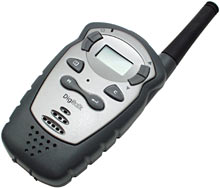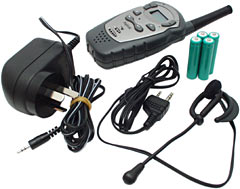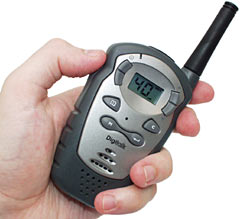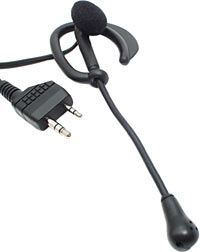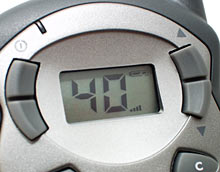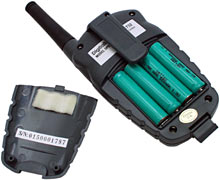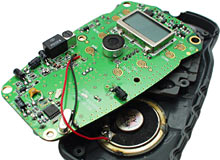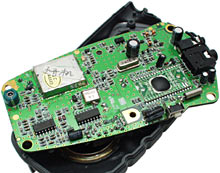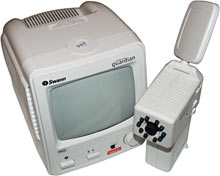
Digitalk Communicator UHF CB radio
Review date: 31 January 2002.Last modified 03-Dec-2011.
When the World Wide Web got rolling and the Internet suddenly became something normal consumers were interested in, umpteen commentators compared this "new" medium to the citizen's band (CB) radio craze of the 1970s.
There was at least one definite point of similarity - lots of people communicating in a new way (well, a new way for them, anyway) and, so far as anybody could determine, enjoying the form of communication as much as, or even more than, the actual information they communicated. People making Web pages in 1994 were, overwhelmingly, doing it for much the same reason that "communications enthusiasts" used CB radio in the 70s - just because they could.
CB radio, like the Internet, also suffered from invasions of... special people... when the barriers to entry got low enough that anybody who could scrape together a hatful of pennies could get access.
Internet access, of course, beats the heck out of CB radio in lots of important ways. Which is why this particular "fad" hasn't faded, and isn't going to.
CB's just a conversational medium, for a start. You talk to people with it, in real time. That's it. Radio amateurs have done all sorts of clever data transfer tricks with public-access frequencies, but as a general rule, nothing's allowed on CB frequencies but speech and the odd radio signal tone.
CB range is also lousy by telephone or e-mail standards, and it's completely untargettable. 27MHz ("11 metre") CB radio users have achieved freakishly long "DX" contacts when atmospheric conditions are right, and one way or another ranges of hundreds of kilometres can routinely be achieved, but if you want to talk to your friend Fred you've still just got to transmit on a calling channel and ask if he's listening. If he isn't, at that moment, you're out of luck.
CB is also a party line. Anybody within range of anybody else on a given frequency can listen to them, talk over them, abuse them, or plug their 8-track player cranking out 101 Hammond Organ Bossa Nova Classics into their cheap Taiwanese over-legal-power transmitter and render the whole channel uninhabitable for as far as the eye can see. CTCSS radio users can even talk over other people without knowing it. The other people know it, all right, but they don't get a say.
This is all because CB provides no elegant way for more than two people on one channel to talk; only one person can send at a time. Since two people talking at once on one channel will step all over each other, people have to use "break" messages to ask other people on a channel to clam up for a moment so they can get a word in. It's like IRC, only more confusing.
So why the heck would any self-respecting computer geek want a CB radio?
Well, as long as you're reasonably close to the person you want to talk to, CB gives you a voice communication system with no usage charges. Little handheld transceivers can have respectable range, impressive feature sets and pleasingly low price tags.
If you're forever paging someone else in the office, or calling someone less than a mile away on your mobile phone, or trying to communicate effectively with your fellow LAN party or concert organisers, or taking multi-car road trips, or going hiking, cheap handheld CB radios can be bloody handy. They're no good if you're discussing assassination plans or where you buried the diamonds, since the world can listen in, but for a lot of chat they're perfectly adequate.
So here's the Digitalk Communicator. Aus PC Market are selling it (well, they were; this review dates to the beginning of 2002, and now they don't stock these radios any more). The Communicator comes in a few different configurations; you can buy the bare handheld by itself for $AU82.50 delivered, or you can get it with a hands-free headset earphone and microphone for $AU99 delivered, or you can get this full kit...
...which gives you the UHF CB transceiver itself (more on what that means in a moment), four nickel metal hydride (NiMH) AAA cells to power it, a plugpack to charge it, and the headset, for $AU121 delivered. If you need a couple of radios, one full Communicator kit and one basic one, plus a few AAA rechargeables from somewhere else, will set you back little more than the price of one similar brand name handheld, without batteries.
It's not big, but it's solidly constructed. I wouldn't trust it to work if I dropped it five storeys onto concrete, but I would expect the Communicator to survive worse treatment than my mobile phone.
The radio comes with a removable belt clip, and you can leave it on your belt if you use the headset. Otherwise, there's a normal push-to-talk button on the side. Plug the headset into the two sockets under the rubber cover on the top of the radio (one of which doubles as the charge socket), put the radio in voice-activated mode (VOX), and it transmits when you talk. The VOX trigger level's adjustable, to compensate for background noise. Presto - CB you can use on a motorbike.
The little LCD display has a green LED backlight, and it makes it pretty easy to change channels and access other radio functions. As well as basic switching through the 40 channels and volume adjustment, there's channel scan to surf automatically through all channels in turn, a Dual Watch function that checks only two channels for activity, a monitor button that overrides the standard squelch function and lets you listen to a channel even when there are no strong signals being transmitted, a button lock to stop unfortunate things happening if you bump keys by mistake, a call tone function to alert receivers to your existence, and a second counter that counts the seconds until a transmission happens and drops you back to receive mode if and when one does. The radio emits helpful pitched beeps as you press buttons, and the user interface is pretty readily comprehensible.
The radio runs from four AAA cells, and the two batteries-included versions of the package give you a set of 550 milliamp-hour (mAh) NiMH cells, and a plugpack charger. The plugpack is only useful as a charger; you can't run the radio from it. If you're using non-rechargeable cells, the radio will still try to charge them if you plug in the AC adapter, which will shortly prove to be a Bad Thing.
CB flavours
You don't need any sort of license for HF or UHF CB here in Australia; anybody can buy a radio and go for it. We use two CB radio bands, here. One's for AM/SSB (Single Side Band) radios and centred on 27MHz; that's High Frequency, or HF, CB. The other one's FM and centred on 476/477MHz; it's Ultra High Frequency, or UHF, CB. The Digitalk radio is a UHF unit.
HF CB has excellent range, but that means that people for many miles around - even over the horizon, when atmospheric conditions are unusual - can talk over you. The 27MHz band's also used by everybody and his dog; interference from other CBers and a plethora of other devices is a problem, even if you're not dealing with interference from the next city.
UHF CB suffers much less from interference and has better sound quality, but its range is much lousier. Anything between a UHF transmitter and receiver - a hill, buildings, trees - will impede the signal to some extent. It's not a complete line-of-sight system, though; UHF CBs work fine in urban areas. You just don't get as much range in the city as you would on the open road, or the open ocean for that matter.
You can get long range from UHF, though, by using repeaters. Repeaters are stationary transceivers set up to receive on one channel and send on another, and UHF CB radios designed for this country - including the Digitalk - automatically use repeater duplex mode when you use a channel designated for that mode.
The UHF CB repeater channels are numbers 1 through 8, with channel 5 reserved for emergency traffic, and the channel pair spacing is the same for all of them - 2 pairs with 32, 3 pairs with 33, and so on. So if you select channel 1, for instance, you'll be receiving on that channel, but transmitting on channel 31, which is the channel the repeater listens on. It retransmits on channel 1 everything it hears on channel 31, and it lets anybody within range of the repeater antenna talk to anybody else in range, even if, without the repeater, they'd be too far apart to talk.
If nobody's actually running a repeater within range of you then you're out of luck, of course, but Australia's urban areas all have at least some of the eight repeater channels covered. In Sydney, for instance, UHF Channel 1 is repeated by a chap in Hurstville whose repeater is instantly recognisable, thanks to its insertion of a "quack quack" sound effect every time someone dekeys (stops transmitting). Opinions concerning the usefulness and entertainment value of this feature differ.
If you've got a full five watt transceiver then the SYD01 repeater should work for you over most of Sydney, but I'm 14 kilometres away from it as the crow flies, and the repeater can't hear the little Digitalk transmitter from this far away.
There are lots of repeaters out in the bush, too. A UHF repeater on top of a mountain can give little handheld radios an effective range of hundreds of kilometres. There's an Australian UHF repeater map here (and, since putting this review up, I've been told about another one here).
There's quite a lot of etiquette and jargon you need to know in order to mix in a civilised fashion with other CBers; the rec.radio.cb FAQ pretty much covers that. For basic walkie-talkie use on a channel that nobody else wants to use, though - which is a situation you're likely to find yourself in fairly often with UHF CB, thanks to its shorter range - you can be as sloppy as you like. If you're using VOX and accidentally broadcast a burp to the world, nobody's going to flame you. Just keep your uneducated behind off channels 5 and 35 (both reserved for emergency calls), and use channel 11 only for calling people and agreeing on some other channel for chat, and not for the chat itself. Channel 40 is also semi-officially designated as the "road" channel, for use only by people on the move.
Range
I haven't done detailed range tests with the Digitalk radios yet, but a one kilometre test, through various buildings and trees, worked fine without repeater assistance. Clear as a bell, no problem. Putting a solid hill in the way, though, dropped the range to only about 500 metres.
These little transceivers are specified as having an "up to five kilometre" range, and there's a good chance they'll actually manage that, in the absence of obstacles. In urban areas, a couple of kilometres is likely to be the outer limit, and any solid geographical features in between will massively reduce it.
In the absence of extreme terrain, five watt UHF CB transmitters can manage ranges up to 20 kilometres. If you're using a low power handheld, you'll be able to hear more powerful transmitters at quite long distances, just as I can hear the SYD01 repeater. But you won't be able to reply unless you get closer.
Power consumption
The Communicator is specified as a half-watt transceiver, a tenth of the maximum allowable power for UHF CB in this country.
Radio power is how much power comes out of a radio's antenna socket, measured into a resistive dummy load. How much power the radio consumes has nothing in particular to do with this. How much actual radio frequency (RF) energy the antenna manages to emit is, of course, limited at the upper end by the radio's power, but is also massively influenced by the antenna's size and design, and how well it's matched to the radio. Little weeny handheld rubber ducky antennas like the Communicator's are not very efficient.
From the 4.8 volts of a set of charged NiMH or NiCd cells, the Digitalk radio draws from 60 to 120 milliamps (mA) when it's receiving something. The exact draw depends on whether anybody's talking on that channel and how high the volume's set; about 100mA, on average, for high volume on an active channel, seems reasonable.
When you're tuned to a channel with nothing going on and you're not using monitor mode (which turns on the speaker even when there's no strong signal, so you can listen to static and weak signals), the radio goes into a standby mode after ten seconds. In standby its current draw pulses, but it averages out at about 10 to 15 milliamps.
The 550 milliamp-hour (mAh) NiMH cells the radio comes with should therefore give it a continuous-listening time of about five hours; that's how long it can sit there squawking away on your belt if you don't actually talk to anyone, but you're tuned to an active channel. 650mAh AAA NiMH cells are easy enough to find these days; they ought to give you another hour.
If you're tuned to a channel nobody's using but you, your standby time should jump to more than 30 hours, with the 550mAh cells.
Press the transmit button and the radio's current draw spikes to at least 250mA, and possibly considerably more. How much power the thing draws depends on the antenna alignment and nearby resonant objects; by playing with the radio inside my metal-walled workshop I managed to get it up to about half an amp in certain positions. 300 to 350mA seems plausible for open-air use, though; that's around an hour and 40 minutes of continuous talk time from the included batteries, which isn't at all bad, for such a tiny radio.
The documentation says the "typical" battery life is meant to be 25 hours, and for light use on a clear channel that's plausible. Your mileage will vary, though.
Using alkaline AAA cells may give you better standby time than any rechargeable, if the pulsed standby current draw doesn't frighten the non-rechargeable batteries too much.
Any old alkaline AAA should manage at least 1000mAh capacity with a constant 10 to 15mA load, and current top-of-the-line brand name cells can manage 1400mAh or more, but this isn't a constant load, so who knows.
Once you start actually listening to something, you're definitely over the amount of current that AAA alkalines can deliver and still provide their full rated capacity. Pressing the transmit button is really mean to them; that'll kill them fast.
In a pinch, though, alkalines or even plain carbon-zinc cells will work in the Communicator, and even when they're quite clapped out they'll still let you receive. Try to transmit and the voltage of well-used non-rechargeables will slump so far that the radio will just turn off, but receive-only's better than nothing.
Inside
At this price point, and when you're dealing with an internationally unrenowned brand like Digitalk, it's not unreasonable to expect that looking inside the casing will reveal something nasty.
Inside the Communicator, though, is what looks like a perfectly well designed and built circuit board. You can see the speaker attached to the case at the bottom, and the small round transducer that makes the radio's beeps; the beeps stay loud no matter what overall volume setting you choose.
The circuit board's replete with surface mount devices...
...and has a decently low population of big ugly discrete components. This board also lacks the we-hung-the-things-on-the-wall-and-threw-solder-at-them assembly quality that aficionadoes of dirt cheap Taiwanese electronics know so well.
Overall
If you're an Australian who's already got some AAA rechargeables and a charger, the radio-only $AU82.50 Communicator package is a pretty good deal. Brand name UHF CBs with similar basic specs generally cost a couple of hundred bucks, ex delivery.
The full $AU121 Communicator package is an even better bargain by handheld standards. More expensive handheld CBs usually have a somewhat higher gain antenna and run from larger batteries that give them better run time, but you'd better believe you pay considerably more than $AU40 on top of their base price to get batteries, a charger and a hands-free kit.
If you need really long range from a UHF handheld then you'll want to drop a few hundred bucks on a five watt transceiver, but for many purposes, a sub-one-watt radio like this one will do. At this price, people who make lots of close-range mobile phone calls may find that a pair of these things will pay for themselves in a few months.
Buy one!
Aus PC Market don't sell this product any
more, but you can still try a price search at
DealTime!
